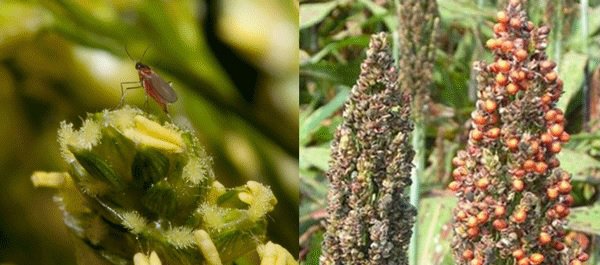

The sorghum midge, Contarinia sorghicola, is a key pest of sorghum throughout tropical and sub-tropical regions of the world and is considered one of the most serious pests of sorghum in these regions. This tiny reddish or orange fly only 1/8 inch long can complete a generation in nine days, and adults only live for 24-48 hours. Eggs are laid at the base of florets at flowering and larvae develop within the developing seed, the pinkish larvae feed on ovaries of seeds and darken to reddish orange as they mature. When adults emerge, an empty, clear-colored pupal case may remain attached to the glumes. Ultimately their feeding results in empty or ‘blasted’ seed capsules.
This is a tropical insect which does not diapause or overwinter in temperate regions such as Kansas. In fact, it is very rare to find any economic damage from midge this far north. In the past, there have been only anecdotal observations of midge activity in southwest Kansas and occasionally along the Oklahoma border. This year, damage appears to be very widespread through central and western Kansas (low grain yields and test weights) in areas which have never before experienced midge infestations. This is probably associated with the long 2018 summer season with lots of humidity in the crop due to above average rainfall amounts. So, 2018 may represent an anomaly, or it may bode a future in which midge infestations become more common in Kansas.
Control requires scouting fields at flowering by knocking heads into a white plastic bucket or cut out gallon milk jug and then looking for the small red flies in the container. Thresholds vary, but generally an average of one fly per head is enough to warrant treatment. Although these insects are easy to kill with contact insecticides, spraying such materials will risk causing resurgence of other pests currently under good biological control, including sugarcane aphid.
A new section on sorghum midge monitoring and management will be included in the 2019 revision of the K-State Sorghum Insect Management Guide.
Information provided by J.P. Michaud, Entomologist, K-State Agricultural Research Center-Hays.
Stacy Campbell, Cottonwood Extension District, Hays.





